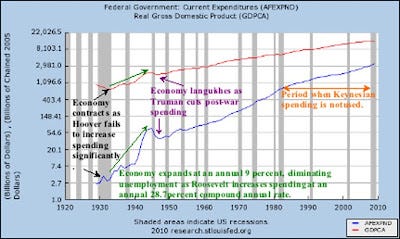RAHN REFUTED
I hardly know how to begin expressing my astonishment at The Washington Times’ publication on August 9, 2010 of the ludicrous The Cato article by Richard W. Rahn: “An Inconvenient Economic History.” One is hard pressed to say whether it is ignorance or deception driving this laughable bit of propaganda masquerading as economics. To take this piece seriously is to abandon whatever claim economics has to science.
Reading the piece I am reminded of the story about a guy who comes upon another fellow in the middle of the night crawling on all fours under a street lamp.
“What are you doing?” the guy asks.
“Looking for my keys” comes the reply.
“Where did you lose them?”
“Over there,” says the man, pointing halfway down the block.
“Then why are you looking here?”
“The light’s better.”
The central premise of Rahn’s piece is that “there is no historical evidence to show that big increases in government spending as a percentage of GDP leads to faster economic growth and more job creation.” Even Paul Krugman can’t find any, Rahn says, because “there isn’t any.”
Oh? How’s this for “Historical Evidence”?

The graph above shows Federal government current expenditures and real GDP plotted on semi-logarithmic scale from 1929 to the present, as supplied by the Federal Reserve Bank of St. Louis. We use semi-log vertical axis so that the slopes of the data in different timeframes can be legitimately compared.
What do the data show?
1. (On the graph) Nowhere in the relatively benign period between 1983 to 2010 chosen by Rahn to make his case do you find evidence of “big increases in government spending” because Hayek, not Keynes was in vogue (at least until the economy cratered in 2008). Government spending was not then used as a tool to manipulate economic growth nor was there a need for it until recently. Tax cuts, deregulation and monetary policy were the chosen tools to stimulate economic and job growth. So in using the 1983-2010 interval to make his case, it’s not surprising that Rahn should find no evidence that “big increases in governments spending leads to faster growth and more jobs.” If you look for it where it ain’t, you’re sure not to find it. He’s basically looking for keys under the street lamp.
2. (On the graph) Where “the keys were lost” and, therefore, where we ought to look, is during the Great Depression of the 1930s and the war years in the early 1940s – essentially the Roosevelt years -- when “big increases in government spending” were the primary means employed to revive the severely depressed economy. Keynes, not Hayek, was then the man. Unlike Rahn’s relatively unperturbed 1983-2010 interval, the 1930s and 1940s show not only significant variability in both government spending and GDP (essential in establishing meaningful correlation), but also an undeniable positive correlation between the two – something Rahn does not want to acknowledge because it totally refutes his thesis.
How does Rahn get around the real “inconvenient historical evidence” from the Roosevelt era? Rahn dismisses the data from the 1930s and 1940s with a howler of a non sequitur, in parenthesis, no less: (“The big spending by Presidents Hoover and Franklin D. Roosevelt just prolonged the Great Depression.”) He implies the prolonged lack of “prosperity” (i.e. the high unemployment) during the Great Depression somehow nullifies data from that period. Say what??
Nonsense. There can be significant increases in GDP and jobs without producing full-employment prosperity for a long time if you start, as FDR did, from a deep enough trough of depression. Rahn wants us to look under the street light rather than where the keys are. Among magicians, this tactic is known as “misdirection.”
What do the data show about the co-variance (synchronous movement) between government spending and GDP growth during the 1930s and 1940s? Were “big increases in government spending” followed by corresponding increases in GDP and jobs? Yes! And were cutbacks in government spending followed by dips in GDP and jobs? Yes! Look at the graph.
In short, the data from the 1930s and 1940s Rahn is so eager for us not to examine, flatly refute his basic contention that “there is no historical evidence to show that big increases in government spending . . . leads to faster economic growth and more job creation.” You don’t even need to digest the numbers: the correlation between government spending and economic growth is obvious just by looking at the graph.

For those fond of numbers, here’s the bottom line: During the Roosevelt years between the trough of the recession in early 1933 and the peak of the wartime boom in early 1945, government spending skyrocketed from $3.4 billion to $70 billion, a compound annual rate of 28.7%. During the same period, real GDP nearly tripled, expanding at a 9% compound annual rate, much faster than anything we’ve experienced in the post-war era. From a peak of 25%, unemployment virtually disappeared as 14 million jobs were created, boosting employment 36% from 38.8 million to 52.8 million.
The data from Roosevelt’s period are so overwhelmingly persuasive and Rahn’s logic for excluding them so transparently false, we must conclude deception rather than ignorance motivates this intellectually bankrupt exercise in right-wing propaganda.
And here’s a caboose to the numbers from the Roosevelt years Rahn and his supply-side sidekicks don’t want you to know: The unprecedented growth produced during Roosevelt’s tenure in office was accompanied by a boost in the top tax rate from 63% to 94% and the income level to which the top bracket applied was cut from $1 million to $200,000 during the war years. According to supply-side dogma, that’s not supposed to happen.
But that’s another story.


